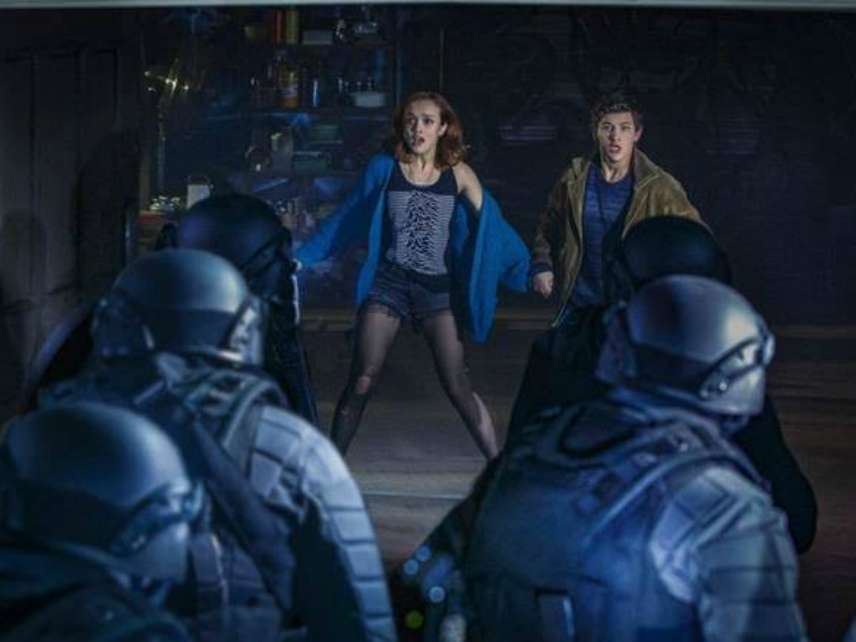Movie Review: Ready Player One
Steven Spielberg's digital fantasy land.

Congratulations on having once watched Akira and Iron Giant and Back to the Future. High fives to everybody who remembers those Tears for Fears and Twisted Sister tracks. And big thumbs up to everyone who recognizes the name Zemeckis, and can spot a Beetlejuice suit, and who knows where Faber College is located (in Animal House). Have we got a movie for you.
I don't mean to be snotty. Fandom is fun, and probably all of us have staked out little swaths of pop-culture history for the enjoyment of ourselves and our fellow cultists. But it's hard not to be a little annoyed by a picture that seeks to salute its audience for something as passive as pop-culture consumption—as if the accrual of vintage minutia were some sort of achievement.
Still, Steven Spielberg's Ready Player One really is fun in some ways. Based on a 2011 sci-fi novel by Ernest Cline (who cowrote the script), the movie is an attempted return to the pulpish glories of Spielberg's earlier career (Close Encounters, E.T., the first three Indiana Jones films) after the commercial strike-out of his last fantasy feature, The BFG, in 2016. In RPO, Spielberg flourishes all of his credentials as a great filmmaker. He handles the movie's action scenes—which are virtually nonstop, and often highly complex—with unflagging clarity; and he makes room for embers of emotional warmth amid all of the film's visual clamor. There's never a feeling that we're in anything other than very good hands.
What spoiled the movie for me, over the long course of two hours and 20 minutes, was its suffocating abundance of digital imagery. There was bound to be a lot of CGI in a movie about life inside a virtual-reality universe, and it's been done very well here. But it rarely lets up, to the point where even the movie's lead performers are often hidden within the digital carapace of their in-game avatars. After a while, you feel as if you're staring at nothingness made manifest.
The story is basic Willy Wonka. The year is 2045, the place, Columbus, Ohio. Our orphaned teen hero, Wade Watts (Tye Sheridan, of X-Men: Apocalypse), is living with his aunt and her slob boyfriend in the Stacks—a sort of slum-on-stilts composed of battered trailers piled atop one another high into the dystopian air. Life sucks, and pretty much everybody owns VR goggles and haptic gloves and spends most of their time in the Oasis—a vast online world created by the late, legendary programmer James Halliday (Mark Rylance). Halliday died 10 years ago, but he left behind an Easter Egg in the Oasis, and whoever finds it will inherit control of his grand digital construct as well as his multi-billion-dollar estate. No one has found the Easter Egg yet, but Wade is among the many who keep searching for it.
The movie announces its obsession with the 1980s (mostly) right at the beginning, with a blast of Van Halen's 1983 hit "Jump." (Why people of the far future should be preoccupied with the cultural effluvia of a decade some 60 years in the past is not explored; we're told that Halliday was nuts about this stuff, and that's that. For the record, Ernest Cline was born in 1972.) We follow Wade into the Oasis, a universe where people can change sex, change species, and visit exotic locales such as Vacation Planet and Planet Doom. Wade's name in the Oasis is Parzival, and we soon meet two of his online friends and fellow Egg-hunters: a punky redhead who calls herself Artemis (Olivia Cooke, of Thoroughbreds) and a very large, Vin Diesel-esque gearhead called Aech (Lena Waithe). Wade has never met these people in real life, but of course he will.
Early on, Spielberg hurls us into a spectacular automotive race filled with souped-up cars and bikes screaming through New York City dodging such towering obstructions as King Kong and a rampaging T. Rex from Spielberg's own cinematic archive. This is top-shelf action design, and the director sweetens it with a bit of light, not especially convincing romance between Wade and Artemis. Then he stirs in some chilly menace in the person of Nolan Sorrento (Ben Mendelson), a greedhead exec with Innovative Online Industries (IOI), a company that wants to take over the Oasis and find ways to monetize it. Boo to him.
As the picture moves along we get holographic check-ins by Halliday, an alarming visit to an IOS "loyalty center," and some nifty one-liners from T.J. Miller, playing Sorrento's hulking online creature I-R0k. There are also two terrific set-piece scenes, both technical triumphs. One takes place in a huge nightclub where dancers float through the air to the dark strains of New Order's "Blue Monday." The other is set in a mockup of The Shining's Overlook Hotel, complete with elevator blood flood and the ghastly crone in Room 237. Following this latter segment of the film, the action settles down to extended cat-and-mousery pitting Sorrento and his evil minions against Wade and Artemis (whom we've by now met in her offline incarnation as a rebel leader of some sort named Samantha).
As the movie wobbles to a soft close, we have time to contemplate its unfortunate shortcomings. Tye Sheridan is a dull leading man here, and you might wish that some screen time had been pried away from him and given instead to Olivia Cooke, who has a more spirited presence. The overload of CGI, with very little let-up, is oppressive, and grows more so as the picture wanders on past the two-hour mark. Also tiring is the spot-that-reference/check-that-artifact game we're expected to play. Yes, yes, that DeLorean does look familiar. And Michael Jackson's red "Thriller" outfit, okay. Bill and Ted, you say?
Is there any nugget of '80s cultural detritus that the filmmakers were unable to cram into this picture? Just as I was wondering that, somebody up on screen shouted, "It's fuckin' Chucky!"


Show Comments (75)